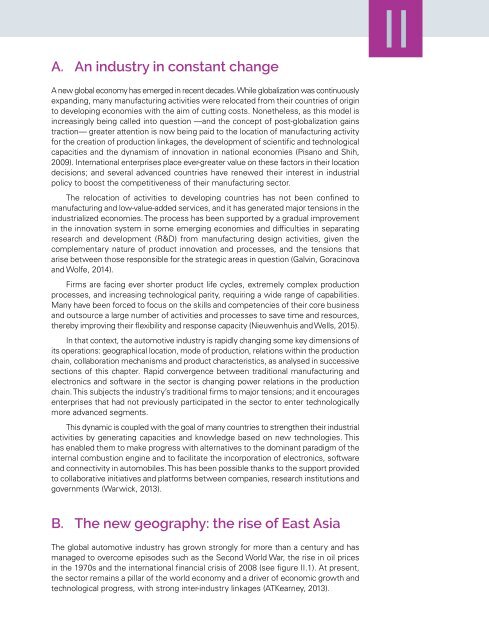Foreign Direct Investment in Latin America and the Caribbean 2017
This publication sets out and analyses the main foreign direct investment (FDI) trends in the countries of Latin America and the Caribbean. The 2017 edition shows that the region is at a difficult juncture. FDI inflows declined by 7.9% in 2016, to US$ 167.043 billion, representing a cumulative fall of 17.0% since the peak in 2011. The fall in commodity prices continues to affect investments in natural resources, sluggish economic growth in several countries has slowed the flow of market-seeking capital, and the global backdrop of technological sophistication and expansion of the digital economy has concentrated transnational investments in developed economies.
This publication sets out and analyses the main foreign direct investment (FDI) trends in the countries of Latin America and the Caribbean. The 2017 edition shows that the region is at a difficult juncture. FDI inflows declined by 7.9% in 2016, to US$ 167.043 billion, representing a cumulative fall of 17.0% since the peak in 2011. The fall in commodity prices continues to affect investments in natural resources, sluggish economic growth in several countries has slowed the flow of market-seeking capital, and the global backdrop of technological sophistication and expansion of the digital economy has concentrated transnational investments in developed economies.
You also want an ePaper? Increase the reach of your titles
YUMPU automatically turns print PDFs into web optimized ePapers that Google loves.
<strong>Foreign</strong> <strong>Direct</strong> <strong>Investment</strong> <strong>in</strong> Lat<strong>in</strong> <strong>America</strong> <strong>and</strong> <strong>the</strong> <strong>Caribbean</strong> • <strong>2017</strong><br />
II<br />
Chapter II<br />
89<br />
A. An <strong>in</strong>dustry <strong>in</strong> constant change<br />
A new global economy has emerged <strong>in</strong> recent decades. While globalization was cont<strong>in</strong>uously<br />
exp<strong>and</strong><strong>in</strong>g, many manufactur<strong>in</strong>g activities were relocated from <strong>the</strong>ir countries of orig<strong>in</strong><br />
to develop<strong>in</strong>g economies with <strong>the</strong> aim of cutt<strong>in</strong>g costs. None<strong>the</strong>less, as this model is<br />
<strong>in</strong>creas<strong>in</strong>gly be<strong>in</strong>g called <strong>in</strong>to question —<strong>and</strong> <strong>the</strong> concept of post-globalization ga<strong>in</strong>s<br />
traction— greater attention is now be<strong>in</strong>g paid to <strong>the</strong> location of manufactur<strong>in</strong>g activity<br />
for <strong>the</strong> creation of production l<strong>in</strong>kages, <strong>the</strong> development of scientific <strong>and</strong> technological<br />
capacities <strong>and</strong> <strong>the</strong> dynamism of <strong>in</strong>novation <strong>in</strong> national economies (Pisano <strong>and</strong> Shih,<br />
2009). International enterprises place ever-greater value on <strong>the</strong>se factors <strong>in</strong> <strong>the</strong>ir location<br />
decisions; <strong>and</strong> several advanced countries have renewed <strong>the</strong>ir <strong>in</strong>terest <strong>in</strong> <strong>in</strong>dustrial<br />
policy to boost <strong>the</strong> competitiveness of <strong>the</strong>ir manufactur<strong>in</strong>g sector.<br />
The relocation of activities to develop<strong>in</strong>g countries has not been conf<strong>in</strong>ed to<br />
manufactur<strong>in</strong>g <strong>and</strong> low-value-added services, <strong>and</strong> it has generated major tensions <strong>in</strong> <strong>the</strong><br />
<strong>in</strong>dustrialized economies. The process has been supported by a gradual improvement<br />
<strong>in</strong> <strong>the</strong> <strong>in</strong>novation system <strong>in</strong> some emerg<strong>in</strong>g economies <strong>and</strong> difficulties <strong>in</strong> separat<strong>in</strong>g<br />
research <strong>and</strong> development (R&D) from manufactur<strong>in</strong>g design activities, given <strong>the</strong><br />
complementary nature of product <strong>in</strong>novation <strong>and</strong> processes, <strong>and</strong> <strong>the</strong> tensions that<br />
arise between those responsible for <strong>the</strong> strategic areas <strong>in</strong> question (Galv<strong>in</strong>, Gorac<strong>in</strong>ova<br />
<strong>and</strong> Wolfe, 2014).<br />
Firms are fac<strong>in</strong>g ever shorter product life cycles, extremely complex production<br />
processes, <strong>and</strong> <strong>in</strong>creas<strong>in</strong>g technological parity, requir<strong>in</strong>g a wide range of capabilities.<br />
Many have been forced to focus on <strong>the</strong> skills <strong>and</strong> competencies of <strong>the</strong>ir core bus<strong>in</strong>ess<br />
<strong>and</strong> outsource a large number of activities <strong>and</strong> processes to save time <strong>and</strong> resources,<br />
<strong>the</strong>reby improv<strong>in</strong>g <strong>the</strong>ir flexibility <strong>and</strong> response capacity (Nieuwenhuis <strong>and</strong> Wells, 2015).<br />
In that context, <strong>the</strong> automotive <strong>in</strong>dustry is rapidly chang<strong>in</strong>g some key dimensions of<br />
its operations: geographical location, mode of production, relations with<strong>in</strong> <strong>the</strong> production<br />
cha<strong>in</strong>, collaboration mechanisms <strong>and</strong> product characteristics, as analysed <strong>in</strong> successive<br />
sections of this chapter. Rapid convergence between traditional manufactur<strong>in</strong>g <strong>and</strong><br />
electronics <strong>and</strong> software <strong>in</strong> <strong>the</strong> sector is chang<strong>in</strong>g power relations <strong>in</strong> <strong>the</strong> production<br />
cha<strong>in</strong>. This subjects <strong>the</strong> <strong>in</strong>dustry’s traditional firms to major tensions; <strong>and</strong> it encourages<br />
enterprises that had not previously participated <strong>in</strong> <strong>the</strong> sector to enter technologically<br />
more advanced segments.<br />
This dynamic is coupled with <strong>the</strong> goal of many countries to streng<strong>the</strong>n <strong>the</strong>ir <strong>in</strong>dustrial<br />
activities by generat<strong>in</strong>g capacities <strong>and</strong> knowledge based on new technologies. This<br />
has enabled <strong>the</strong>m to make progress with alternatives to <strong>the</strong> dom<strong>in</strong>ant paradigm of <strong>the</strong><br />
<strong>in</strong>ternal combustion eng<strong>in</strong>e <strong>and</strong> to facilitate <strong>the</strong> <strong>in</strong>corporation of electronics, software<br />
<strong>and</strong> connectivity <strong>in</strong> automobiles. This has been possible thanks to <strong>the</strong> support provided<br />
to collaborative <strong>in</strong>itiatives <strong>and</strong> platforms between companies, research <strong>in</strong>stitutions <strong>and</strong><br />
governments (Warwick, 2013).<br />
B. The new geography: <strong>the</strong> rise of East Asia<br />
The global automotive <strong>in</strong>dustry has grown strongly for more than a century <strong>and</strong> has<br />
managed to overcome episodes such as <strong>the</strong> Second World War, <strong>the</strong> rise <strong>in</strong> oil prices<br />
<strong>in</strong> <strong>the</strong> 1970s <strong>and</strong> <strong>the</strong> <strong>in</strong>ternational f<strong>in</strong>ancial crisis of 2008 (see figure II.1). At present,<br />
<strong>the</strong> sector rema<strong>in</strong>s a pillar of <strong>the</strong> world economy <strong>and</strong> a driver of economic growth <strong>and</strong><br />
technological progress, with strong <strong>in</strong>ter-<strong>in</strong>dustry l<strong>in</strong>kages (ATKearney, 2013).


















